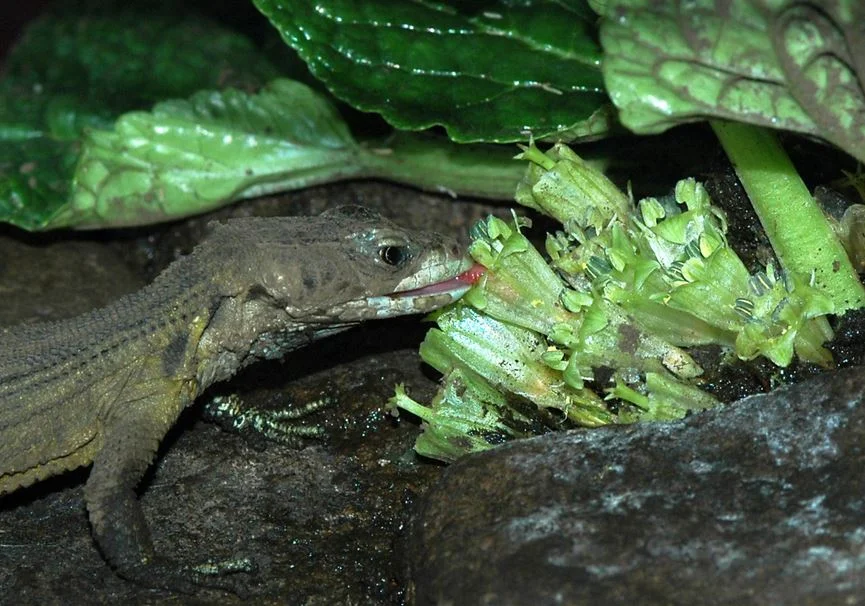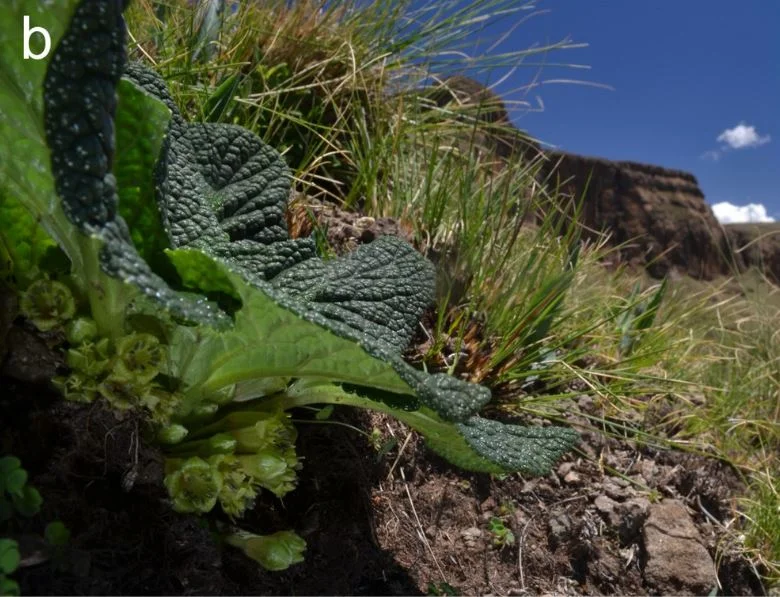With its compact growth habit and small, inconspicuous flowers tucked under its leaves, it seems like Guthriea capensis doesn’t want to be noticed. Indeed, it has earned itself the common name of '“hidden flower.” That’s not to say this plant is unsuccessful. In fact, it seems to do just fine tucked in among high-elevation rock crevices of its home range along the Drakensberg escarpment of South Africa. Despite its cryptic nature, something must be pollinating these plants and recent research has finally figured that out. It appears that the hidden flower has a friend in some local reptiles.
Lizard pollination is not unheard of ([1] & [2]), however, it is by no means a common pollination syndrome. This could have something to do with the fact that we haven’t been looking. Pollination studies are notoriously tricky. Just because something visits a flower does not mean its an effective pollinator. To investigate this properly, one needs ample hours of close observation and some manipulative experiments to get to the bottom of it. Before we get to that, however, its worth getting to know this strange plant in a little more detail.
The hidden flower is a member of an obscure family called Achariaceae. Though a few members have managed to catch our attention economically, most genera are poorly studied. The hidden flower itself appears to be adapted to high elevation environments, hence its compact growth form. By hugging the substrate, this little herb is able to avoid the punishing winds that characterize montane habitats. Plants are dioecious meaning individuals produce either male or female flowers, never both. The most interesting aspect of its flowers, however, are how inconspicuous they are.
The hidden flower (Guthriea capensis) in situ.
Flowers are produced at the base of the plant, out of site from most organisms. They are small and mostly green in color except for the presence of a few bright orange glands near the base of the style, deep within the floral tube. What they lack in visibility, they make up for in nectar and smell. Each flower produced copious amounts of sticky, sugar-rich nectar. They are also scented. Taken together, these traits usually signal a pollination syndrome with tiny rodents but this assumption appears to be wrong.
Based on hours of video footage and a handful of clever experiments, a team of researchers from the University of KwaZulu-Natal and the University of the Free State have been able to demonstrate that lizards, not mammals, birds, or insects are the main pollinators of this cryptic plant. Two species of lizard native to this region, Pseudocordylus melanotus and Tropidosaura gularis, were the main floral visitors over the duration of the study period.
Pseudocordylus melanotus
Tropidosaura gularis photo © 2009 Serban Proches licensed under CC BY-SA 2.5
Visiting lizards would spend time lapping up nectar from several flowers before moving off and in doing so, picked up lots of pollen in the process. Being covered in scales means that pollen can have a difficult time sticking to the face of a reptile but the researchers believe that this is where the sticky pollen comes into play. It is clear that the pollen adheres to the lizards’ face thanks to the fact that they are usually covered in sticky nectar. By examining repeated feeding attempts on different flowers, they also observed that not only do the lizards pick up plenty of pollen, they deposit it in just the right spot on the stigma for pollination to be successful. Insect visitors, on the other hand, were not as effective at proper pollen transfer.
Conspicuously absent from the visitation roster were rodents. The reason for this could lie in some of the compounds produced within the nectar. The team found high levels of a chemical called safranal, which is responsible for the smell of the flowers. Safranal is also bitter to the taste and it could very well serve as a deterrent to rodents and shrews. More work will be needed to confirm this hypothesis. Whatever the case, safranal does not seem to deter lizards and may even be the initial cue that lures them to the plant in the first place. Tongue flicking was observed in visiting lizards, which is often associated with finding food in other reptiles.
Male flower (a) and female flower (b). Note the presence of the orange glands at the base.
Another interesting observation is that the color of the floral tube and the orange glands within appear to match the colors of one of the lizard pollinators (Pseudocordylus subviridis ). Is it possible that this is further entices the lizards to visit the flowers? Other reptile pollination systems have demonstrated that lizards appear to respond well to color patterns for which they already have some sort of sensory bias. Is it possible that these flowers evolved in response to such a bias? Again, more work will be needed to say for sure.
By excluding vertebrates from visiting the flowers, the team was able to show that indeed lizards appear to be the main pollinators of these plants. Without pollen transfer, seed set is reduced by 95% wheres the additional exclusion of insects only reduced reproductive success by a further 4%. Taken together, it is clear that lizards are the main pollinators of the enigmatic hidden flower. This discovery expands on our limited knowledge of lizard pollination syndromes and rises many interesting questions about how such relationships evolve.






